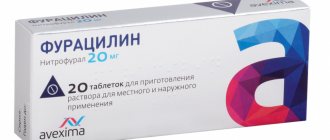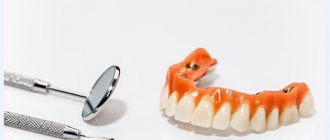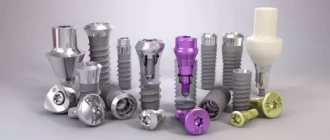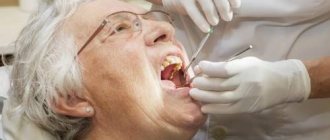Which teeth exactly have such a strange name?
So, the term “eye teeth” is not a medical term. The correct name for these teeth is upper canines. Where did such a strange name come from? The fact is that in the immediate vicinity of the upper fangs there are threads of the facial nerve. When these threads are irritated, very severe pain occurs in the upper part of the face. This pain even extends to the eyes.
When babies' upper canines begin to erupt, pain occurs that makes children cry. Unfortunately, this process takes quite a long time. Removal of eye teeth in adults is also always accompanied by severe pain. In this case, dentists use very strong anesthesia.
From somewhere there are ridiculous rumors that a person can even go blind from the removal of eye teeth. Such cases are unknown to medicine.
Features of growth and difficulties during the teething period
When eye teeth start cutting in, they usually cause a lot of trouble. This process is usually preceded by certain symptoms that indicate the imminent appearance of the first fangs. As mentioned above, their serial number is 3, but due to the greater length of the root, they appear later than the first molars. Eye teeth should grow before 24 months - this is considered normal. It is also worth noting that teeth on the upper jaw usually appear a little earlier than on the lower jaw.
“I, too, when I remember that time when the first fangs began to appear, it makes me shiver. We started viewing them at the age of one and a half years, everything is as it should be. But the child suffered so much even before they arrived. It all started with an eye pain. When we arrived at the therapist, he immediately said that it was teeth coming out and referred me to a dentist. The doctor recommended painkillers and ointment to calm the inflammation. After a few days it became easier, but it was something else..."
Kristina D.R., Nizhny Novgorod, from correspondence on the woman.ru forum
Teething is a test for a child
So, the main signal that fangs are beginning to grow is acute pain. There are often cases when the optic nerve becomes inflamed, causing not only the gums, but also the eyes to hurt. Because the child experiences constant discomfort and pain, he may have restless sleep and increased sensitivity to bright light. For this reason, experts do not recommend long walks during the day during this period. Other symptoms are similar to signs of growth of other teeth, except that in this case the intensity of their manifestation will be several times higher. Among these manifestations are the following:
- high temperature - how many days it can last depends on the individual characteristics of the body and the baby’s immune system, usually 3-4 days,
- excessive salivation
- gingivitis and other inflammatory diseases of the soft tissues of the oral cavity,
- severe swelling of the mucous membrane in the place where the tooth should appear,
- discharge from the nostrils, the appearance of which is caused by increased activity of the salivary glands.
Teething of fangs causes the greatest discomfort and pain.
If the root of a growing tooth touches the optic nerve, the child may cry for no reason. If inflammatory processes occur, conjunctivitis may develop1.
External features of eye teeth
Eye teeth are visually very different from both the front teeth and molars. The eye tooth has only one root. It is relatively long and slightly flattened. The crowns of the eye teeth have two cutting edges located at an acute angle to each other. They also have a slightly flattened shape.
The upper eye teeth are noticeably larger and longer than the lower ones. Their cutting surface is much wider than that of the lower canines.
Nature entrusted these teeth to hold food in the mouth and tear food into pieces.
Features of fangs
The first canine is formed in the embryo's body at the time of intrauterine development. Like other masticatory organs, these units originate from the dental epithelial lamina. Their main difference is that they are deeply embedded in the bone tissue. Permanent rudiments also begin to form in babies in the womb. This happens according to the principle of time units. What are the cardinal distinctive features of fangs? They differ from other chewing organs primarily in structure.
- The root shape is significantly elongated.
- The cutting edge connects to the large crown at a pointed angle.
- The units in the upper jaw are all larger than those in the lower row, since the contact surface is increased.
- The canines have flat crowns. Therefore, the lips and tongue do not come into contact with the cutting edge.
If a child's fangs grow crookedly, this problem cannot be ignored. The baby needs to be taken to the dentist. The specialist will identify the cause and prevent serious complications. If the bite is incorrect, children's braces will be required. Wearing them is mandatory so that the body does not suffer from gastrointestinal diseases due to inadequate chewing.
Formation of eye teeth in children
Children's milk teeth erupt in a strictly defined sequence. Each tooth is waiting its turn to appear in the baby’s mouth.
Children's eye teeth begin to erupt only after all the incisors and first molars have appeared. The upper canines begin to erupt first. This usually happens at the age of one and a half years. The lower canines begin to appear when the baby is 20 months old.
This delay is explained by the fact that the roots of the eye teeth penetrate into the depths of the bone tissue much deeper than the other teeth.
During eye teething, children experience more than just pain. Most of them experience a slight increase in body temperature. Running noses and even swelling in the oral cavity often occur. Young mothers often perceive all this as a child’s illness. Meanwhile, this is a completely natural, albeit unpleasant, process. It cannot be any other way, because at this time the gums next to the baby’s teething teeth become inflamed.
Only in the rarest cases can babies experience coughing, diarrhea and even vomiting at this time. However, these are symptoms of another random disease that has nothing to do with the appearance of eye teeth.
Teething disorders - symptoms and treatment
In case of teething problems, symptomatic treatment is carried out. Its purpose is to eliminate pericoronitis, oral abscess and osteomyelitis.
Treatment of pericoronitis
Treatment of pericoronitis is carried out on an outpatient basis. If the tooth germ is positioned correctly and there is enough space for the dental arch, then surgical treatment is the most preferable option. The mucous membrane in the area of the tooth crown is completely excised. As a result, access to the chewing and lateral surfaces of the crown appears. The operation is performed under anesthesia and can be performed either with scissors or a scalpel, or with more modern methods: cryodestruction, laser and electric knife.
pericoronarotomy can be performed - an operation during which the mucous membrane above the tooth crown is dissected. As a result, tooth surfaces that were previously covered by a hood of mucous membrane are exposed.
After surgical treatment, drug therapy :
- Antibacterial agents are selected individually, taking into account the microflora. It can be:
- Inhibitor-protected penicillins that destroy anaerobic and aerobic microorganisms. Amoxicillin with clavulanic acid is most effective.
- Lincomycin and Clindamycin act against Staphylococcus aureus.
- Metronidazole is not effective against facultative anaerobes and aerobes, but together with other antibiotics it will help cope with mixed microflora.
- Cephalosporins act only together with Metronidazole and Clindamycin, since almost all anaerobic microorganisms are insensitive to them.
- The latest generations of fluoroquinolones are effective against gram-positive bacteria, but each drug has its own level of activity.
- Non-steroidal anti-inflammatory drugs.
- Antihistamines [10].
- Detoxification therapy consists of drinking plenty of warm drinks rich in vitamins, such as compotes and fruit drinks. Sometimes in difficult situations, an isotonic solution is administered intravenously.
To alleviate local symptoms and reduce inflammation, baths with antiseptic solutions are used: a pale pink solution of potassium permanganate, 0.01% Miramistin solution or 0.05% Chlorhexidine.
Treatment of oral abscess
Treatment for an oral abscess includes surgery and medication. Depending on the location of the abscess and the general condition of the patient, it can be performed in a clinic or in a hospital. During the operation, the purulent-inflammatory focus is opened, the postoperative wound is treated with antiseptics and drained.
After surgery, medications must be prescribed. They are similar to those used to treat pericoronitis. To detoxify, it is recommended to drink plenty of alkaline liquids, such as mineral water and cranberry juice.
For several days after the operation, the wound is bandaged daily and treated with antiseptics.
Treatment of osteomyelitis
If osteomyelitis is detected, the patient is immediately hospitalized. The erupting tooth is removed, and all purulent foci are carefully treated. Antibacterial drugs are administered intravenously. For detoxification, saline solutions are used, which are also administered intravenously.
How to ease the baby's suffering?
It is impossible to ensure completely painless eruption of eye teeth. However, you can help your baby in several ways.
A light massage of the gums slightly dulls the pain. In any case, this stops the kids from crying. To do this, you need to gently stroke the gum just above the eye tooth for a couple of minutes. This massage can be done two to three times a day.
Now pharmacies sell special teethers. Before using, keep them in the refrigerator for a while. These simple products are filled with distilled water. If the baby bites through the shell, then nothing bad will happen.
You can dull the pain with the help of anesthetic gels Dentinox, Kalgel or Kamistad. They begin to act a few minutes after application to the gums.
If the baby’s nose is stuffy during the teething of the eye teeth, then in this case it is worth using drops of Otrivin, Nazivin or Quix. They tend to constrict blood vessels. It also happens that the body temperature of babies rises to 38 degrees or higher. In this case, you have to resort to antipyretic children's drugs paracetamol or ibuprofen. They are available in the form of syrups or candles.
If the baby is having too much trouble with the teething of the eye teeth, then in such a situation it is better to call a pediatrician at home.
Prevention
The main rule for the prevention of any problems during teething has been and remains thorough and daily oral hygiene, even in infancy.
Other tips from pediatric dentists to remember:
- Avoid the use of children's dishes and hygiene items by adults. This way you can introduce unfavorable microflora into the delicate body of a child.
- Minimize sugar in your diet, especially before bed
- The child should receive foods enriched with beneficial microelements every day - cottage cheese, cheese, raisins, seaweed, etc.
- Literally from the first days of proper nutrition, teach your child to rinse his mouth after eating.
- As soon as the first signs of teething appear, teach your child to brush his teeth, doing it with baby toothpaste twice a day.
- Visit your pediatric dentist at least twice a year, and monthly if you suspect any irregularities.
Eye teeth in teenagers
The permanent lower eye teeth are formed at the age of 9-10 years. The upper fangs appear after 1-2 years.
In a healthy child, the formation of permanent eye teeth is painless. If this process is accompanied by pain, then this indicates a serious problem. This usually happens if diseases of the oral cavity occur, such as gumboil, pulpitis, periodontitis or other inflammatory processes. In such a situation, you should not try to get rid of the problem yourself. The most you can do is take a painkiller and immediately go to the dentist.
What are teeth called in dentistry: designation systems
- Two-digit numbering. Designation in accordance with international standards. In addition to the tooth number, the quadrant of the oral cavity is indicated. Quadrant numbering starts from the top right side with 1, then to the top left side (2), bottom left (3) and bottom right (4). If the number 21 is written, then we are talking about the central left incisor of the upper jaw.
- Square-digital. In this case, the jaw is divided into two equal areas. The elements of the dental system are counted from 1 to 8. For the most accurate identification of a dental unit, the number, jaw and location are prescribed.
- Universal. An accessible designation in which each unit of the dentition is assigned a number from 1 to 32. The Latin alphabet is used to identify primary teeth.
In addition, the alphanumeric and Haderup systems are used, but they are used extremely rarely in practice.









